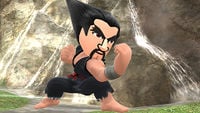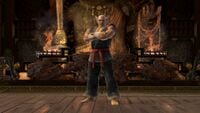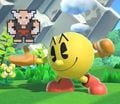Heihachi Mishima: Difference between revisions
(→Origin) |
(→Origin) |
||
| Line 21: | Line 21: | ||
==Origin== | ==Origin== | ||
Heihachi Mishima is a major antagonist/protagonist in the ''Tekken'' series of fighting video games, and the archenemy of his son [[Kazuya Mishima]]. He was born to Jinpachi Mishima, a renowned martial artist and the founder of the Mishima Zaibatsu corporation. Heihachi overthrew and murdered his father Jinpachi Mishima in order to take control of his company and begin a criminal empire. He soon bore a son, Kazuya Mishima, but found him to be weak and threw him off of a cliff in order to test his strength when he was five years old. Years later, when Heihachi hosted a martial arts tournament called the King of the Iron Fist, Kazuya returned in order to exact revenge on his father. Kazuya defeated him, threw him off the same cliff, and assumed control of the Zaibatsu, continuing his father's criminal practices. | Heihachi Mishima is a major antagonist/protagonist in the ''Tekken'' series of fighting video games, and the archenemy of his son [[Kazuya Mishima]]. He was born to Jinpachi Mishima, a renowned martial artist and the founder of the Mishima Zaibatsu corporation. Heihachi overthrew and murdered his father Jinpachi Mishima in order to take control of his company and begin a criminal empire. He soon bore a son, Kazuya Mishima, but found him to be weak and threw him off of a cliff in order to test his strength and to see if he had the Devil Gene when he was five years old. Years later, when Heihachi hosted a martial arts tournament called the King of the Iron Fist, Kazuya returned in order to exact revenge on his father. Kazuya defeated him, threw him off the same cliff, and assumed control of the Zaibatsu, continuing his father's criminal practices. | ||
Heihachi would later return and retake control of his corporation by defeating Kazuya in the next King of Iron Fist tournament and dropping him to his death into a volcano; it was around this time that he discovered that his son had been saved by the Devil Gene, and he now seeks this in order to attain ultimate power, going so far as to manipulate his grandson, Jin Kazama, who also bears the Devil Gene, into entering a new King of Iron Fist tournament 19 years after the last one in order to obtain the power of an ancient battling deity known as Ogre, whom Jin wanted to defeat to avenge the supposed death of his mother, Jun Kazama. | Heihachi would later return and retake control of his corporation by defeating Kazuya in the next King of Iron Fist tournament and dropping him to his death into a volcano; it was around this time that he discovered that his son had been saved by the Devil Gene, and he now seeks this in order to attain ultimate power, going so far as to manipulate his grandson, Jin Kazama, who also bears the Devil Gene, into entering a new King of Iron Fist tournament 19 years after the last one in order to obtain the power of an ancient battling deity known as Ogre, whom Jin wanted to defeat to avenge the supposed death of his mother, Jun Kazama. | ||
Revision as of 13:03, August 15, 2022
| Heihachi Mishima | |
|---|---|
{{{content1}}}
{{{content2}}}  Official artwork of Heihachi from Tekken Tag Tournament 2 and Tekken 7. | |
| Universe | Tekken |
| Debut | Tekken (1994) |
| Smash Bros. appearances | SSB4 SSBU |
| Most recent non-Smash appearance | Astro's Playroom (2020, cameo) |
| Console/platform of origin | Arcade |
| Species | Human |
| Gender | Male |
| Place of origin | Japan |
| Created by | Seiichi Ishii |
| Voice actor | Unshō Ishizuka |
| Article on Wikipedia | Heihachi Mishima |
Heihachi Mishima (三島 平八, Mishima Heihachi) is a recurring playable fighter from the Tekken universe.
Origin
Heihachi Mishima is a major antagonist/protagonist in the Tekken series of fighting video games, and the archenemy of his son Kazuya Mishima. He was born to Jinpachi Mishima, a renowned martial artist and the founder of the Mishima Zaibatsu corporation. Heihachi overthrew and murdered his father Jinpachi Mishima in order to take control of his company and begin a criminal empire. He soon bore a son, Kazuya Mishima, but found him to be weak and threw him off of a cliff in order to test his strength and to see if he had the Devil Gene when he was five years old. Years later, when Heihachi hosted a martial arts tournament called the King of the Iron Fist, Kazuya returned in order to exact revenge on his father. Kazuya defeated him, threw him off the same cliff, and assumed control of the Zaibatsu, continuing his father's criminal practices.
Heihachi would later return and retake control of his corporation by defeating Kazuya in the next King of Iron Fist tournament and dropping him to his death into a volcano; it was around this time that he discovered that his son had been saved by the Devil Gene, and he now seeks this in order to attain ultimate power, going so far as to manipulate his grandson, Jin Kazama, who also bears the Devil Gene, into entering a new King of Iron Fist tournament 19 years after the last one in order to obtain the power of an ancient battling deity known as Ogre, whom Jin wanted to defeat to avenge the supposed death of his mother, Jun Kazama.
While Jin came out victorious, Heihachi immediately ordered Tekken Force, the Mishima Zaibatsu's private paramilitary squad, to murder him, with Heihachi delivering what would be the killing shot, were it not for the Devil Gene within Jin awakening in the nick of time and saving him from certain death. Two years later, as Heihachi attempted to have a new lifeform created based on Ogre's DNA samples taken from the site of his battle with Jin, he discovered that a sample of the Devil Gene was necessary to do so; around this time, he learned that Zaibatsu rivals G Corporation had exhumed Kazuya's corpse and successfully brought him back to life, and so he decided to organize a fourth King of Iron Fist tournament, with the Zaibatsu as grand prize, in order to lure both Kazuya and Jin in, in which he succeeds, leading to a battle at the shrine of Hon-Maru, in which Jin, powered by the Devil Gene, defeats both his father and his grandfather, but spares them both in Jun's name. Soon after Jin vanishes into the night, a squad of JACK robots, deployed by G Corporation, break into the Hon-Maru in order to capture both Mishimas. Heihachi seemingly perished in the explosion after being left to die by Kazuya, but he survived and went into hiding, reappearing one month later when the fifth King of Iron Fist tournament is announced.
He also enters the sixth tournament in order to take the Zaibatsu, which had been taken over by Jin at the end of the previous tournament back for himself. It is later revealed how everything came to be: years ago, he met his then-future wife, Kazumi, who had been sent to train under Jinpachi Mishima, Heihachi's father, and with time she and Heihachi fell in love, got married and had Kazuya. However, one day, Kazumi confronted Heihachi, by saying he would one day become a threat to the world, and revealed that her real intentions in marrying him were to murder him on behalf of the Hachijo clan. As they fought, she manifested Devil powers, and Heihachi had no other option but to kill the only woman he ever loved. After recounting these events to a mysterious journalist, Heihachi goes off to confront Kazuya one final time at the mouth of a volcano. The duel ends with Heihachi's apparent death, and his body being dropped into the boiling lava by Kazuya, repaying Heihachi a second time.
Barring Banjō Ginga in the first and Wataru Takagi in the second Tekken games, Daisuke Gōri was famous for providing his voice in subsequent titles, until Tekken 6 as he passed away on January 17, 2010 with Unshō Ishizuka voicing him as of Tekken: Blood Vengeance and onwards until his passing on August 13, 2018.
In Super Smash Bros. 4
As a costume

Heihachi was considered as a possible playable character from Namco, according to an interview with Masahiro Sakurai. However, Sakurai felt that Heihachi's movements would have been difficult to implement.[1]
Heihachi is the basis for a paid downloadable content costume for Mii Brawlers. The costume resembles Heihachi's rejuvenated appearance that debuted in Tekken Tag Tournament 2. It was first shown at the end of Ryu's reveal trailer, with Ryu and a Mii Brawler with the costume attacking each other simultaneously, referencing how Heihachi and Ryu had previously appeared together in the crossover titles Namco × Capcom, Street Fighter X Tekken and Project X Zone.
Although it isn't available in-game, "Dist Thins Out (Character Select)" from Tekken 6 is used in the costume's reveal. The same song would later be used for the costume's reveal in Ultimate.
In Super Smash Bros. Ultimate
Heihachi was mentioned again during Mr. Sakurai Presents "Kazuya" as not being chosen as a playable character, having been passed over this time for his son Kazuya, whose Devil Gene afforded him greater flexibility in the design of his moveset. Heihachi does not have the Devil Gene; Kazuya instead inherited it from his mother, Kazumi.
Heihachi cameos in pixel form during Pac-Man's Namco Roulette taunt. The sprite is taken from Tekken Tag Tournament 2, and is based on his older, gray-haired appearance from Tekken 3 onwards.
As a background character
Heihachi appears on Mishima Dojo as a background character, using his aforementioned older appearance. Heihachi uses a voice archive from Tekken 3D Prime Edition through Tekken 7, provided by the late Unshō Ishizuka. If parts of walls and ceiling are broken, he will get up and react to it with his arms crossed.
As a costume
He was reintroduced as a Mii Brawler costume, still based on his younger Tekken Tag Tournament 2 design, on June 22nd, 2020 and returned with the release of Challenger Pack 6 on June 29th, 2020.
In his costume trailer in Ultimate, Heihachi is seen performing a forward throw on Wolf into Maka Wuhu on Wuhu Island, as a direct reference to Heihachi tossing his son, Kazuya, into a volcano after defeating him in Tekken 2 as revenge for Kazuya throwing him off a cliff after defeating him in the previous game. He is then shown fighting Yoshi, as a reference to the Tekken character Yoshimitsu, who is sometimes called "Yoshi" by his fanbase. Additionally, it could serve as a reference to Alex, a dinosaur fighter from the same series.
Spirit
Heihachi Mishima also appears as a Legend-class primary spirit in the Tekken DLC Spirit Board.
Heihachi uses a Mii Brawler puppet fighter wearing a Dragon Helmet and black Fighter Uniform and is fought on the Mishima Dojo stage. If the player has already purchased the Heihachi DLC costume, Heihachi will use a Mii Brawler puppet fighter wearing a Heihachi Wig and Outfit instead. During the battle, the Mii Brawler will suddenly receive a Final Smash when they reach high damage, referencing Heihachi's Rage Drive, which increases the power of his physical attacks.
Heihachi's spirit battle is also notable for having the Mii Brawler resemble Heihachi, as opposed to the standard Mii Brawler.
| No. | Image | Name | Type | Class | Slots | Base |
Max |
Base |
Max |
Base |
Max |
Ability | Series |
|---|---|---|---|---|---|---|---|---|---|---|---|---|---|
| 1476 | Heihachi Mishima | ★★★★ | ⬡⬡ | 4240 | 10,604 | 2403 | 6009 | 1636 | 4090 | Fist & Foot Attack ↑ | Tekken Series |
Gallery
Names in other languages
Trivia
- Heihachi is the only DLC Mii costume whose series has a DLC character in Ultimate to not be released at the same time as his respective character. In his case, his costume was released alongside Challenger Pack 6 while Kazuya is part of Challenger Pack 10, which also happened to release exactly one year apart from one another.
External links
- Article on the Tekken Wiki
- Heihachi's official Mii on the Mii Library
References
| Character Inspirations for Mii Fighter Costumes in Super Smash Bros. 4 | |
|---|---|
| Akira · Captain Falcon · Flying Man · Heihachi · Jacky · King K. Rool · Knuckles · Toad | |
| Ashley · Black Knight · Chrom · Dunban · Gil · Link · Lloyd · Monster Hunter · Takamaru · Viridi · Zero | |
| Fox · Geno · Inkling · Isabelle · K.K. Slider · MegaMan.EXE · Proto Man · Samus · Tails · X | |
| Headgear only | Barbara · Chain Chomp · Chocobo · Daisy · Inkling Squid · Luigi · Majora's Mask · Mario · Meta Knight · Peach · Red Shell · Sheik · Shy Guy · Spiny · Super Mushroom · Waluigi · Wario · Zelda |
|
| |
|---|---|
| Fighter | Kazuya (SSBU) |
| Stage | Mishima Dojo |
| Other | Heihachi Mishima |
| Spirits | Spirits |
| Music | Ultimate |





